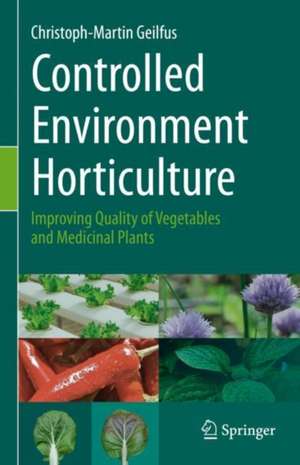Controlled Environment Horticulture: Improving Quality of Vegetables and Medicinal Plants
Autor Christoph-Martin Geilfusen Limba Engleză Hardback – 2 sep 2019
The first part of the book introduces the concept of Controlled Environment Horticulture as a horticultural production technique used to maximize yields via the optimization of access to growing factors. The second part describes the use of this production technique in order to induce stress responses in the plant via the modulation of these growing factors and, importantly, the way that this manipulation induces defence reactions in the plant resulting in the production of compounds beneficial for human health. The third part provides guidance for the implementation of this knowledge in horticultural production.
| Toate formatele și edițiile | Preț | Express |
|---|---|---|
| Paperback (1) | 418.80 lei 38-44 zile | |
| Springer International Publishing – 2 sep 2020 | 418.80 lei 38-44 zile | |
| Hardback (1) | 362.71 lei 3-5 săpt. | +20.91 lei 5-11 zile |
| Springer International Publishing – 2 sep 2019 | 362.71 lei 3-5 săpt. | +20.91 lei 5-11 zile |
Preț: 362.71 lei
Preț vechi: 437.00 lei
-17% Nou
Puncte Express: 544
Preț estimativ în valută:
69.41€ • 72.20$ • 57.30£
69.41€ • 72.20$ • 57.30£
Carte disponibilă
Livrare economică 24 martie-07 aprilie
Livrare express 08-14 martie pentru 30.90 lei
Preluare comenzi: 021 569.72.76
Specificații
ISBN-13: 9783030231965
ISBN-10: 3030231968
Pagini: 222
Ilustrații: XV, 233 p. 41 illus., 36 illus. in color.
Dimensiuni: 155 x 235 x 13 mm
Greutate: 0.45 kg
Ediția:1st ed. 2019
Editura: Springer International Publishing
Colecția Springer
Locul publicării:Cham, Switzerland
ISBN-10: 3030231968
Pagini: 222
Ilustrații: XV, 233 p. 41 illus., 36 illus. in color.
Dimensiuni: 155 x 235 x 13 mm
Greutate: 0.45 kg
Ediția:1st ed. 2019
Editura: Springer International Publishing
Colecția Springer
Locul publicării:Cham, Switzerland
Cuprins
Preface.- Part 1. Introduction.- Chapter 1. Introduction.- Chapter 2. Protected Cropping in Horticulture.- Chapter 3. Plant Secondary Compounds.- Chapter 4. Hydroponic Systems in Horticulture.- Part 2. Controllable Production Factors in Horticulture.- Chapter 5. Light.- Chapter 6. Nutrient deficiencies.- Chapter 7. Salt stress.- Chapter 8. Drought Stress.- Chapter 9. Thermal Stress.- Chapter 10. Wounding.- Chapter 11. Mycorrhiza.- Chapter 12. Microbial and Plant-Based Biostimulants.- Chapter 13. Mineral Biofortification.- Chapter 14. CO2 Enrichment.- Chapter 15. Hormones.- Chapter 16. Intercropping.- Part 3. Exercise.- Chapter 17. Acrylamide Concentrations of Deep-fried Potatoes.- Chapter 18. Enrichment of Anthocyanin in Pak Choi.- Chapter 19. Improving Flavor of Tomatoes.- Chapter 20. Biofortification of Carrots.- Chapter 21. Enrichment of Flavonoids in Lettuce.- Chapter 22. Effect of Germination Substrates on Tomato Plants.- Index.
Notă biografică
Christoph-Martin Geilfus, horticulturist and agronomist, born in 1983, studied Agriculture and Agrobiotechnology in Giessen, Germany. He received a doctorate and habilitated in Plant Nutrition in Kiel, Germany. After working as a visiting professor in Leuven, Belgium, he was appointed as Professor for Controlled Environment Horticulture at Berlin, Germany. His research interests include horticulture, the mineral nutrition of crops, apoplastic stress signalling and guard cell biology.
Textul de pe ultima copertă
An understanding of crop physiology and ecophysiology enables the horticulturist to manipulate a plant’s metabolism towards the production of compounds that are beneficial for human health when that plant is part of the diet or the source of phytopharmaceutical compounds.
The first part of the book introduces the concept of Controlled Environment Horticulture as a horticultural production technique used to maximize yields via the optimization of access to growing factors. The second part describes the use of this production technique in order to induce stress responses in the plant via the modulation of these growing factors and, importantly, the way that this manipulation induces defence reactions in the plant resulting in the production of compounds beneficial for human health. The third part provides guidance for the implementation of this knowledge in horticultural production.
The first part of the book introduces the concept of Controlled Environment Horticulture as a horticultural production technique used to maximize yields via the optimization of access to growing factors. The second part describes the use of this production technique in order to induce stress responses in the plant via the modulation of these growing factors and, importantly, the way that this manipulation induces defence reactions in the plant resulting in the production of compounds beneficial for human health. The third part provides guidance for the implementation of this knowledge in horticultural production.
Caracteristici
First textbook to describe how to improve qualities of horticultural crops Instructions for exercises are provided Strategies to enrich active ingredients in medicinal plants
